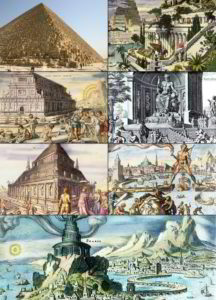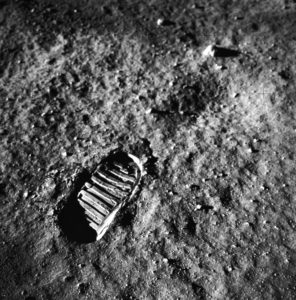by Helen Jameson, Editor-in-Chief SpaceWatch.Global
When humanity pushed its boundaries to the Moon nearly 50 years ago, did anyone really think about what would be left behind long after the astronauts had gone? They came. They saw. They left. However, that is not the case. There is a movement that is gathering momentum, fighting to ensure that these sites of huge historical significance are not forgotten, but are preserved for the sake of future generations and exploration of space.

When we say the word ‘archaeology’, it conjures up images of groups of students and enthusiasts in vests, shorts and Indiana Jones hats, digging through dusty excavation trenches with trowels and brushes, measuring and labelling bits of bone and ceramic and unearthing foundations of ancient civilisations. The perception is that archaeology is the investigation of sites deep in our past, but the truth is that archaeology can apply to something much more recent than that. Our archaeological footprint is growing.
A few years ago, I watched a fascinating documentary about Professor and space archaeologist, Sarah Parcak, who uses satellite technology to unearth ancient Roman, Egyptian and other sites of importance. She has had great success in her field of expertise – Egypt – where she has been able to identify a vast array of undiscovered settlements, tombs and pyramids using the incredibly detailed imagery from the likes of Google Earth and also private satellite companies like DigitalGlobe. I had come across aerial observation of sites using aircraft before, and the completely different perspective that a bird’s eye view can give, enabling the identification of earthworks that had lain undiscovered for centuries and millennia. The idea of using satellites made even more sense. My interest at this point was well and truly piqued.
Then I discovered another level of space archaeology. You see, whilst Parcak is looking down on Earth from the satellite, there are other space archaeologists looking the other way….into space. I delved deeper and I realised that this kind of archaeology has been going on for nearly two decades. At SpaceWatch.Global, we try to take a slightly different perspective on space. We are interested in how space affects humanity, and how humanity affects space. The subject of space archaeology encapsulates all of this.
‘Space archaeology is the research-based study of various human-made items found in space, their interpretation as clues to the adventures mankind has experienced in space, and their preservation as cultural heritage.’ – Capelotti, P.J. (November–December 2004). “Space: The Final [Archaeological] Frontier”.
As we progress as a species towards space, the question of what happens to sites of archaeological and cultural significance becomes a burning one. The European Space Agency (ESA) is talking about a Moon Base; private companies are actively working to get back to the Moon; space tourism is becoming a reality; SpaceX’s long term goal of manned missions to Mars is a step closer with the recent launch of the Falcon Heavy, and asteroid mining is no longer the stuff of science fiction. These are all real projects that are being worked on today. Some or all of these ambitious goals might be realised; we don’t yet know for sure but the fact is that at some point, something will happen – and the Moon is set to be our first port of call. Isn’t it vitally important that, before any of us actually get back to the Moon, we are taking serious steps to protect precious cultural locations such as the Apollo landing sites, to make sure they are safe from contamination and that artefacts are not simply removed and placed on

eBay? As time, technology and ambitions move on, it’s becoming increasingly urgent. If you have ever seen the film Avatar you will be aware of the potential destruction that could befall these precious sites through lack of knowledge and concern. Though it may seem the stuff of science fiction, it no longer is. This is science fact and sooner or later, humanity will again set foot on the Moon, whether it is through robots or people. It would be culturally devastating if those very first landing sites, those first footprints, were lost forever because they had been left unprotected.
But it’s not just the Moon. Archaeological artefacts are on Mars with exploration rovers such as Curiosity and Opportunity. There are significant artefacts orbiting our Earth right now that chart our history and development in space such as the Vanguard satellite that is still being tracked. The International Space Station is going to be hugely significant to our cultural heritage in space and something very interesting is going on here. Led by Dr. Alice Gorman and Dr. Justin Walsh, the ISS Archaeological Project is examining the ‘microsociety in a mini world’ thus extending the discipline of archaeology into a completely new context. It is the first ever, large-scale archaeological investigation of a human habitation site in space and it will be key to understanding how human behaviour adapts in such a completely different environment to the one in which humans have evolved. By tracking patterns of astronauts and objects, Gorman and Walsh are hoping to determine the pattern of life in the ISS in the same way as archaeologists treat sites on Earth. It is truly fascinating.
The whole concept of space archaeology and protecting our cultural heritage in space may demand a change in mindset. It does at first appear to be a complete departure from the traditional, classical archaeology that we are used to. However, the principals are very much the same. We ask you to forget what you think you know and to immerse yourself in a week of contributions and Q&As on this subject.
In this, the latest in our series of SpaceWatch.Global Themed Week, we take a focused look at our cultural heritage in space through interviews and contributions from those who are at the cutting edge of the science itself and also through the eyes of those planning a return to the Moon. We have been lucky enough to speak with Dr. Lisa Westwood, Dr. Beth O’Leary and Dr. Alice Gorman – all pioneers of the field. We have contributions from For All Moonkind’s Michelle Hanlon, who is spearheading

the charge for legislation that will preserve our space heritage on the Moon. We speak to PTScientists, the team of scientists and engineers who are working to send the very first private mission to the Moon next year and discover the ways in which they are planning their project around the preservation of the Apollo 17 landing site, which they will investigate. We also have a contribution from The Sanctuary Project, which will send a time capsule with PTScientists’ ALINA spacecraft that explores who we are today.
Our presence in space is getting older. In 2019, it will be 50 years since Neil Armstrong set foot on the Moon. As the space age matures, NewSpace will usher in the next era and new technology to push boundaries and also more objects into space. Before we get too wrapped up in what’s to come, we should look at what has already happened and how this has shaped our journey into space over the last five decades. Look how far we have come in terms of technological development – the size of satellites, the complexity of spacecraft, the capabilities of launchers. Space is gaining momentum, and that is even more reason to protect the past and learn from it.
 SpaceWatch.Global An independent perspective on space
SpaceWatch.Global An independent perspective on space

